Magnetic proximity sensors are non-contact devices that detect the presence of magnetic objects, such as permanent magnets, by sensing the magnetic field produced by the object. These sensors offer a wide range of applications across various industries, from power distribution to robotics and factory automation. In this comprehensive guide, we will explore the technical details, features, and diverse applications of magnetic proximity sensors.
Understanding Magnetic Proximity Sensors
Magnetic proximity sensors can have either a linear or binary output. In a linear output, the sensor’s voltage is proportional to the strength of the magnetic field, while in a binary output, the sensor acts as a switch, changing state when the magnetic field strength exceeds or falls below a specific threshold.
Sensor Output Types
- Linear Output: The sensor’s output voltage is directly proportional to the strength of the detected magnetic field. This allows for precise measurement and control applications.
- Binary Output: The sensor switches between two states (on/off) based on a predefined magnetic field strength threshold. This is commonly used for proximity detection and position sensing.
Sensor Features and Capabilities
Magnetic proximity sensors offer several features that make them suitable for a wide range of applications:
- Detection through Non-Magnetic Materials: These sensors can detect the presence of magnetic objects through materials such as plastic, wood, and non-magnetizable metals, making them versatile for various industrial settings.
- Long Sensing Ranges: Magnetic proximity sensors can have sensing ranges up to 70 mm, allowing for remote detection and monitoring.
- Compact Designs: These sensors come in both cylindrical and rectangular housings, enabling integration into space-constrained applications.
- High Mechanical Stability: Magnetic proximity sensors are designed to withstand shock and vibration, ensuring reliable performance in demanding environments.
- Flush or Non-Flush Installation: These sensors can be installed in non-magnetizable metals either flush or non-flush, providing flexibility in mounting options.
Hall Effect Sensors

Hall effect sensors are a type of magnetic sensor that measure the magnitude of a magnetic field. They are commonly used for proximity sensing, positioning, speed detection, and current sensing applications. Often, a Hall effect sensor is combined with threshold detection, allowing it to function as a switch.
Hall Effect Sensor Applications
- Proximity Sensing: Hall effect sensors can detect the presence of magnetic objects, enabling applications such as position monitoring and object detection.
- Positioning: These sensors can accurately measure the position of a moving object by detecting changes in the magnetic field.
- Speed Detection: Hall effect sensors can be used to measure the speed of a rotating or moving object by detecting changes in the magnetic field.
- Current Sensing: Hall effect sensors can measure the magnitude of an electric current by detecting the magnetic field generated by the current.
Advantages of Magnetic Proximity Sensors
Magnetic proximity sensors offer several advantages that make them a preferred choice in various industrial applications:
- Protected Contacts: The hermetic glass bulb and inert gas environment protect the sensor’s contacts from dust, oxidation, and corrosion, ensuring long-term reliability.
- Magnetic Actuation: The contacts are activated by a magnetic field rather than mechanical parts, reducing wear and tear.
- Long Contact Life: The special surface treatment of the contacts ensures extended contact life, minimizing maintenance requirements.
- Ease of Operation: Magnetic proximity sensors are maintenance-free and easy to operate, simplifying integration and deployment.
- Compact Design: These sensors have a reduced size, allowing for efficient integration into space-constrained applications.
Industrial Applications of Magnetic Proximity Sensors
Magnetic proximity sensors find widespread use in various industrial applications, including:
- Power Distribution Units (PDUs): These sensors are used for contactless current sensing, monitoring power distribution and consumption.
- Robotics and Factory Automation: Magnetic proximity sensors are employed for linear and angular position sensing, as well as rotation sensing, in robotic and automated systems.
- White Goods: Magnetic proximity sensors are used in household appliances, such as washing machines and refrigerators, for position and motion detection.
- Green Energy: These sensors are utilized in renewable energy systems, such as wind turbines and solar panels, for monitoring and control applications.
Conclusion
Magnetic proximity sensors are versatile and reliable devices that play a crucial role in a wide range of industrial applications. With their ability to detect magnetic objects through various materials, long sensing ranges, and robust design, these sensors offer a compelling solution for proximity sensing, positioning, speed detection, and current sensing tasks. By understanding the technical details and diverse applications of magnetic proximity sensors, engineers and technicians can effectively integrate these devices into their systems, optimizing performance and enhancing overall system functionality.
References:
– Dynamic Rep, “Exploring the Different Types of Proximity Sensors: Object Detection,” 2023-06-09.
– RS Components, “A Complete Guide to Proximity Sensors,” 2023-01-24.
– LinkedIn, “Magnetic Proximity Sensor Market Segmentation Qualitative and Quantitative,” 2023-08-25.
– IOPscience, “Magnetic sensors-A review and recent technologies,” 2023-02-15.
– Robu.in, “Magnetic Proximity Sensor-Working Principle, Applications,” 2020-04-28.

The lambdageeks.com Core SME Team is a group of experienced subject matter experts from diverse scientific and technical fields including Physics, Chemistry, Technology,Electronics & Electrical Engineering, Automotive, Mechanical Engineering. Our team collaborates to create high-quality, well-researched articles on a wide range of science and technology topics for the lambdageeks.com website.
All Our Senior SME are having more than 7 Years of experience in the respective fields . They are either Working Industry Professionals or assocaited With different Universities. Refer Our Authors Page to get to know About our Core SMEs.